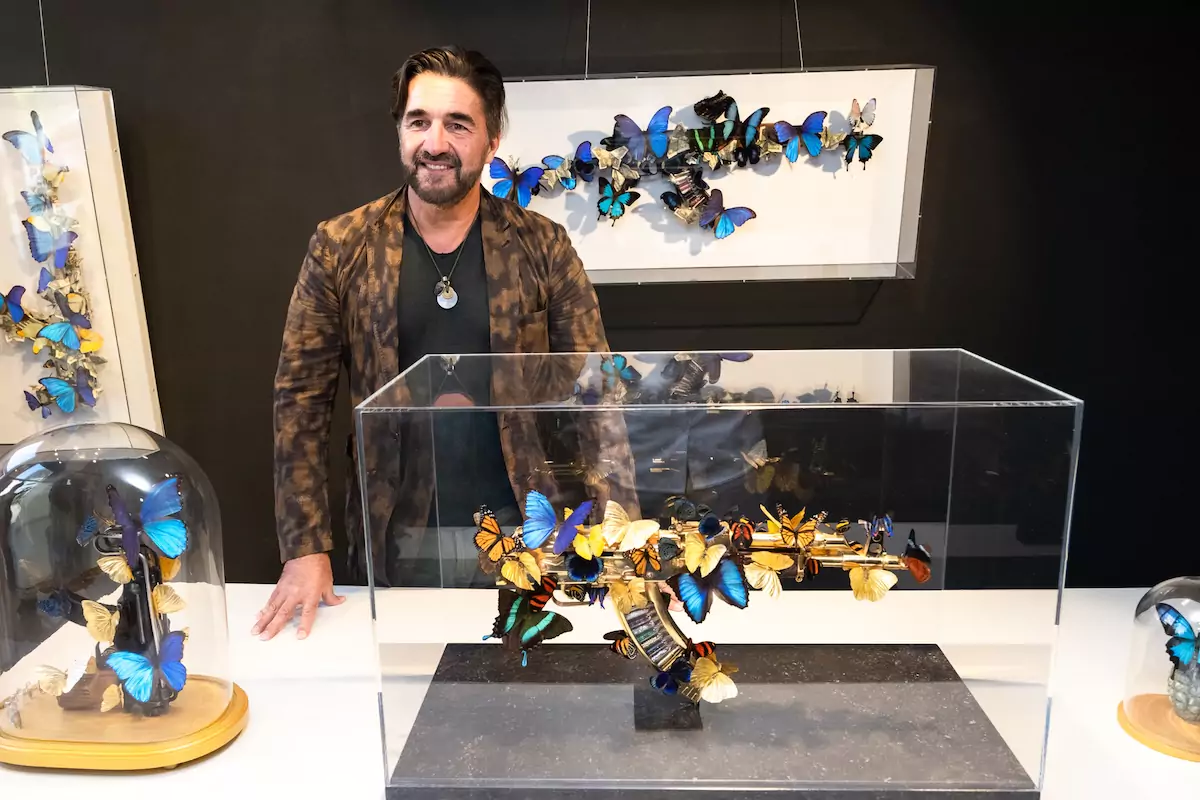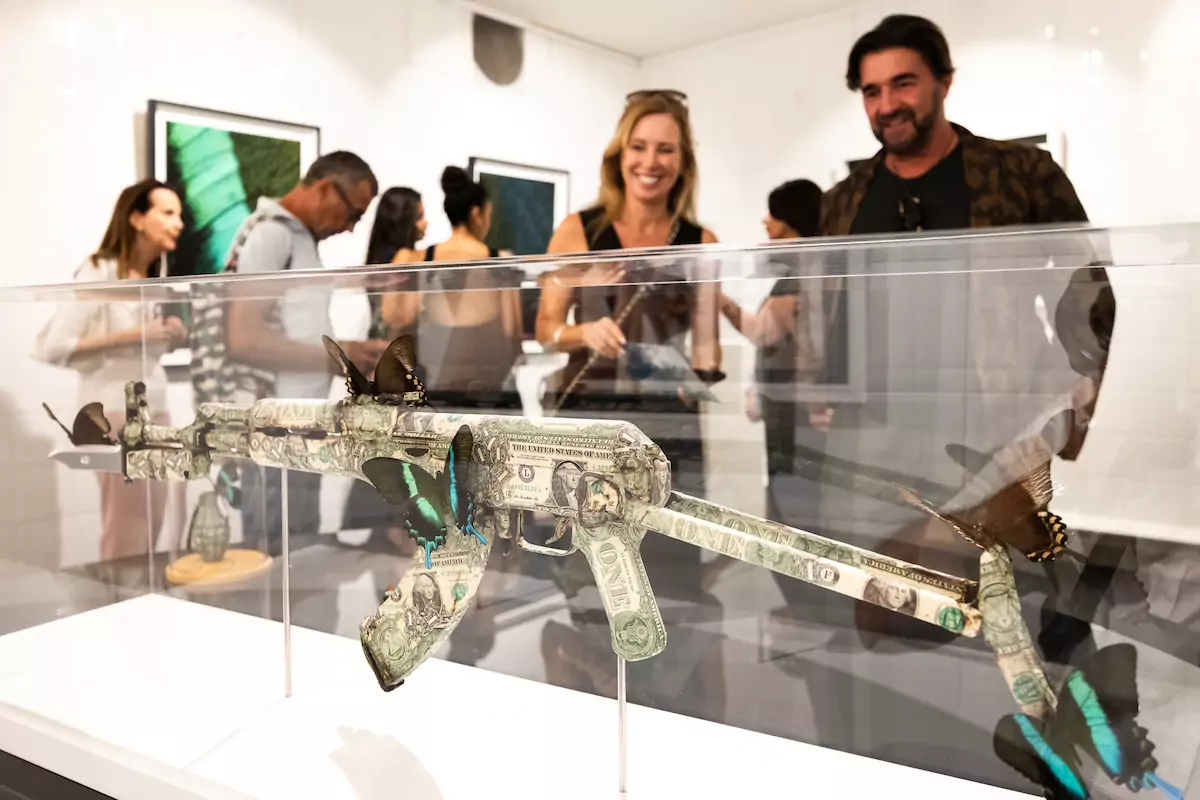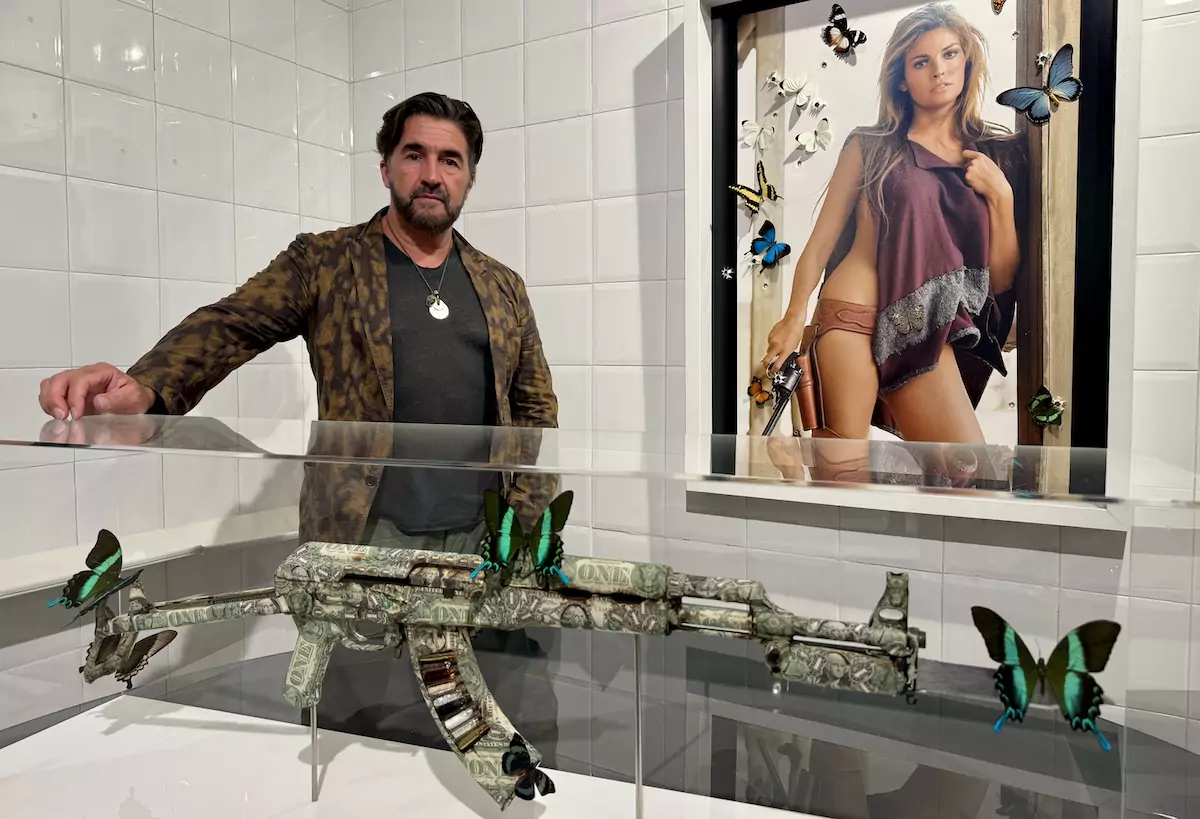British artist and award-winning photographer Bran Symondson has brought his thought-provoking and emotionally charged works to Monte-Carlo this week as part of Monaco Art Week, exhibiting at the HOFA / YellowKorner gallery alongside some of the most recognisable names in art history. Known globally for turning decommissioned AK-47s into intricate symbols of peace and transformation, Symondson’s pieces fuse delicate elements like real butterfly wings, dollar bills and hand-blown glass bullets to deliver layered commentary on violence, power, and the fragility of life.
His journey from Special Forces soldier to internationally acclaimed artist is as complex as the artworks themselves. What began as a photographic exploration in Afghanistan evolved into a groundbreaking artistic practice that challenges viewers to confront the aesthetics of conflict.
In this exclusive interview with Monaco Life’s Cassandra Tanti, Bran Symondson reflects on the moments that defined his creative path and the symbolism behind his striking pieces.
Cassandra Tanti: You began your career as a photographer and served in the British Army Special Forces Reserves. How did those dual roles influence each other and later your art?
Bran Symondson: Well, they influenced it because, firstly, I was in Afghanistan when the moment came upon me to make artworks from AK-47s. There’s a little story behind that. I was photographing the Afghan National Police—we were working alongside them, training them—and I started noticing a feminine side to their behavior. They would wear eyeliner, dye their hair with henna, and even decorate their AK-47s with stickers or freshly picked roses.
I started photographing this because my background was in advertising, fashion, and portraiture. Normally, because we were Special Forces, we weren’t allowed to take photos, but they asked me to because they knew I was a photographer. So, I was recording what was going on.
I also encountered the chai boys—young boys serving commanders in the absence of women—which highlighted a deeply complex and troubling cultural landscape.
One day, while out on patrol with one of these boys, we came under fire. We dived into a ditch, and I remember nervously laughing with him, clutching only my camera. I wasn’t armed. That moment was pivotal. I thought: if I make it out alive, wouldn’t it be powerful to use the AK-47—not as a weapon, but as a blank canvas?
The AK-47 is such a globally recognised weapon system. It symbolises so many different things depending on where you’re from—terrorism, freedom. It was used in Cuba, Vietnam, Africa, China. So I thought: why not disarm it and use it as a canvas for artwork? And it snowballed from there.

So you use decommissioned AK-47s. How do you select the different materials for your pieces?
It depends on the narrative. That piece behind you, Change, is all about the environment. This other piece is about how we beautify brutality. I think about what’s happening in Israel right now, and how social media and the news can whitewash what’s really going on and who’s actually being affected.
My work touches on relevant subjects—environmental issues, civil rights. Those are the two main areas I try to explore. I’ve worked a lot with Human Rights Watch and other charities. Often, I’m asked to make something on a specific subject, so I’ll do that.
The bullets are key to each individual piece—they carry the symbolism. The meaning often lies in what’s inside the bullets.
What are the other influences in your work?
Sometimes it depends on the butterfly species. That piece behind you features Morpho butterflies and origami dollar bills. It represents Mother Nature and capitalism fighting each other—very symbolic.
When I’m creating a piece, I try to make a balance. I’ve used a lot of primary colors—yellows, blues—and different butterfly species. It really depends on the concept of the piece.

Butterflies are very delicate. How difficult is it to work with them?
When I first started, I broke a lot. But now I’ve gotten the hang of handling them. I rehydrate, clean, and open them up—that’s a big part of the process. I position the wings exactly where I want them and try to mix up the species, because often the underwing is just as beautiful as the top.
The irony of butterflies and guns is not lost on me. Do most people see that contrast too?
Absolutely. Whenever I speak to people, there’s always a strong symbolism with butterflies. Many have experienced a butterfly landing on them during an emotional moment or after someone has passed. For me, it’s also a spiritual thing.
The Mayans believed the monarch butterflies flying into Mexico were the spirits of their ancestors. I love that idea.
You flip the object of violence into something more beautiful. What emotional response do you hope viewers have to your artwork?
I hope they understand how weapon systems can be disarmed—it’s about perception. Some people are initially scared off because it’s built on a weapon. But once they see the narrative, they understand the layers of symbolism.
I like to think I’m doing a small part to take weapons out of the hands of people who shouldn’t have them.
Do you have a particular location or exhibit that stands out as special?
The Royal Army Museum showed some of my works last year. They displayed them beautifully—in a way I’d never seen before—next to an actual AK-47 and Saddam Hussein’s gold AK-47.
It was amazing to be a part of that. There were a lot of kids walking through on school trips. I was just hiding in the shadows, listening to their reactions. They were really intrigued by the butterflies and the symbolism.
How do you prepare such an incredible weapon for this purpose?
The AK-47 arrives at the studio deactivated—it can’t be fired. But I still have to remind myself that I’m working on something that, in all likelihood, may have killed someone. Many of the guns I get come from conflict zones. Some have people’s initials inscribed on them.
The butterflies take days to prepare. I select and source them from specialists. Some species go in and out of availability depending on how well they’re bred. Once I have them, I rehydrate and pin them. Then I assess the weapon system and decide how I want to approach it.
The bullets are all hand-blown in London, made in kilns by craftsmen who also make pharmaceutical glassware. Once I’ve worked out the narrative of the piece, I fill the bullets with symbolic elements and begin work.
I always use the American dollar because it represents so many things: greed, capitalism. But in the end, it really depends on how the viewer interprets it.
What do your colleagues in the Army Reserve think?
They love it. They’re always intrigued. I recently made a piece for one of my mates—it went to auction for a fundraiser and fetched a lot of money. That was a proud moment. I think, to date, with all my charity auction donations, it’s around £2 million. I work a lot with charities that support veterans with PTSD. That’s my way of staying involved with the guys.
You’ve collaborated with high-profile figures like Damien Hirst, Antony Gormley, and Terry O’Neill. Is there an artist you’d love to work with next?
If I could go back in time, I would have loved to work with Salvador Dalí. He’s like my hero.
Right now, I’m working with a company called Everrati. They make high-end, battery-powered sports cars—taking classic models and converting them. I’ve done an art piece with them, and I’m also collaborating with some fashion brands.
You’re exhibiting during Monaco Art Week, alongside works from Francis Bacon, Picasso, Warhol, and Chagall. How does it feel to be among these masters?
Honestly, I feel quite humbled. I think artists only really make a definitive mark on the world once they’re dead (laughs). But yeah, I do have those pinch-myself moments.
Still, it’s like anything—if you’re passionate about something, you just keep your head down and do what you love. Then one day you look up and find yourself in a place you never imagined.
Practical Information
-
Exhibition Title: Bran Symondson – The Art to Disarm
-
Presented by: HOFA Gallery in partnership with YELLOWKORNER Monte Carlo
-
Dates: On view until the end of October 2025
-
Location:
YELLOWKORNER Monte Carlo
Palais de la Scala
1 Avenue Henry Dunant, Monte Carlo
Stay updated with Monaco Life: sign up for our free newsletter, catch our podcast on Spotify, and follow us across Facebook, Instagram, LinkedIn, and Tik Tok.
Main photo of Bran Symondson by Cassandra Tanti, Monaco Life
